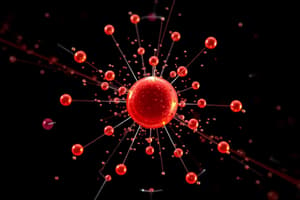Podcast
Questions and Answers
Who performed the experiments at the suggestion of Ernst Rutherford in 1911?
Who performed the experiments at the suggestion of Ernst Rutherford in 1911?
H. Geiger and E. Marsden
What did Ernst Rutherford discover by scattering alpha-rays from metal foils?
What did Ernst Rutherford discover by scattering alpha-rays from metal foils?
The atomic nucleus
What did Ernst Rutherford propose as the model of the atom?
What did Ernst Rutherford propose as the model of the atom?
The planetary model of the atom
What is the approximate thickness of the gold foil used in the experiment?
What is the approximate thickness of the gold foil used in the experiment?
How were the scattered alpha-particles observed in the experiment?
How were the scattered alpha-particles observed in the experiment?
What was the main conclusion drawn from the Geiger-Marsden experiment?
What was the main conclusion drawn from the Geiger-Marsden experiment?
Why did Rutherford argue that the nucleus of an atom must be densely concentrated?
Why did Rutherford argue that the nucleus of an atom must be densely concentrated?
Explain the significance of the size comparison between the nucleus and the atom.
Explain the significance of the size comparison between the nucleus and the atom.
How do atomic electrons affect the deflection of alpha particles in Rutherford's model of the atom?
How do atomic electrons affect the deflection of alpha particles in Rutherford's model of the atom?
What does the scattering data in Figure 12.3 suggest about the interaction of alpha particles with atoms?
What does the scattering data in Figure 12.3 suggest about the interaction of alpha particles with atoms?
Flashcards are hidden until you start studying




